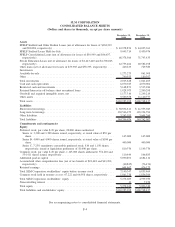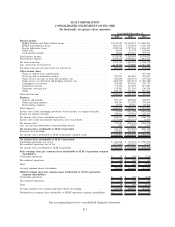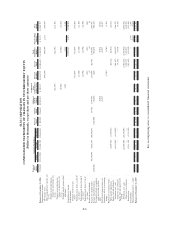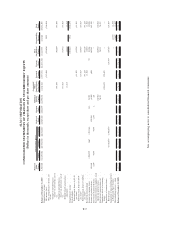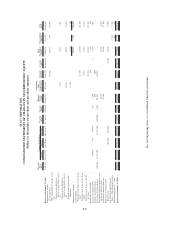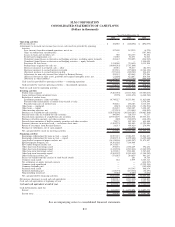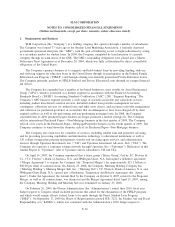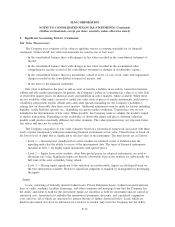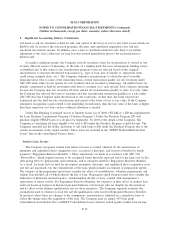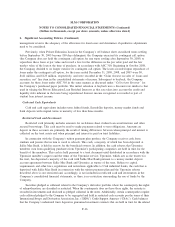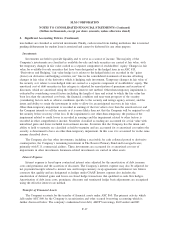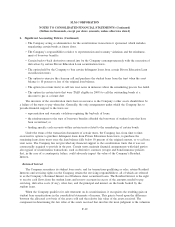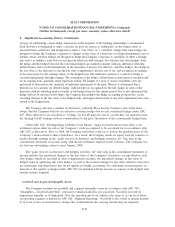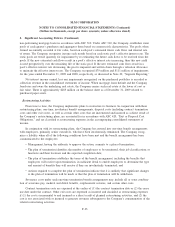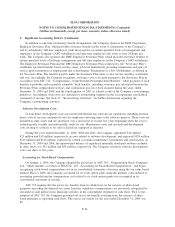Sallie Mae 2009 Annual Report Download - page 141
Download and view the complete annual report
Please find page 141 of the 2009 Sallie Mae annual report below. You can navigate through the pages in the report by either clicking on the pages listed below, or by using the keyword search tool below to find specific information within the annual report.2. Significant Accounting Policies (Continued)
Additionally, interest earned on student loans reflects potential non-payment adjustments in accordance with
the Company’s non-accrual policy as discussed further in “Allowance for Student Loan Losses” below.
The Company recognizes certain fee income (primarily late fees and forbearance fees) on student loans
according to the contractual provisions of the promissory notes, as well as the Company’s expectation of
collectability. Student loan fee income is recorded when earned in “other income” in the consolidated
statements of income.
Allowance for Student Loan Losses
The Company maintains an allowance for loan losses at an amount sufficient to absorb losses incurred in
its FFELP loan and Private Education Loan portfolios at the reporting date based on a projection of estimated
probable credit losses incurred in the portfolio. The Company analyzes those portfolios to determine the
effects that the various stages of delinquency and forbearance have on borrower default behavior and ultimate
charge-off. The Company estimates the allowance for loan losses for its loan portfolio using a migration
analysis of delinquent and current accounts. A migration analysis is a technique used to estimate the likelihood
that a loan receivable may progress through the various delinquency stages and ultimately charge off, and is a
widely used reserving methodology in the consumer finance industry. The Company also uses the migration
analysis to estimate the amount of uncollectible accrued interest on Private Education Loans and write-off that
amount against current period interest income. The evaluation of the allowance for loan losses is inherently
subjective, as it requires material estimates that may be susceptible to significant changes. The Company’s
default estimates are based on a loss confirmation period of generally two years (i.e., the Company’s
allowance for loan loss covers the next two years of expected losses). The two-year estimate of the allowance
for loan losses is subject to a number of assumptions. If actual future performance in delinquency, charge-offs
and recoveries are significantly different than estimated, this could materially affect the Company’s estimate
of the allowance for loan losses and the related provision for loan losses on the Company’s income statement.
The Company believes that the Private Education Loan and FFELP allowance for loan losses are appropriate
to cover probable losses incurred in the student loan portfolio.
When calculating the allowance for loan losses on Private Education Loans, the Company divides the
portfolio into categories of similar risk characteristics based on loan program type, loan status (in-school,
grace, forbearance, repayment, and delinquency), underwriting criteria (FICO scores), and existence or absence
of a cosigner. As noted above, the Company uses historical experience of borrower default behavior and
charge-offs to estimate the probable credit losses incurred in the loan portfolio at the reporting date. Also, the
Company uses historical borrower payment behavior to estimate the timing and amount of future recoveries
on charged off loans. The Company then applies the default and collection rate projections to each category of
loans. Once the quantitative calculation is performed, management reviews the adequacy of the allowance for
loan losses and determines if qualitative adjustments need to be considered. One technique for making this
determination is through projection modeling, which is used to determine if the allowance for loan losses is
sufficient to absorb credit losses anticipated during the loss confirmation period. Projection modeling is a
forward-looking projection of charge-offs. Assumptions that are utilized in the projection modeling include
(but are not limited to) historical experience, recent changes in collection policies and procedures, collection
performance, and macroeconomic indicators. Additionally, management considers changes in laws and
regulations that could potentially impact the allowance for loan losses.
The current and future economic environment is taken into account by the Company when calculating the
allowance for loan loss. The Company analyzes key economic statistics and the impact they will have on
future charge offs. Key economic statistics analyzed as part of the allowance for loan loss are unemployment
rates (total and specific to college graduates), consumer confidence and other asset type delinquency rates
F-14
SLM CORPORATION
NOTES TO CONSOLIDATED FINANCIAL STATEMENTS (Continued)
(Dollars in thousands, except per share amounts, unless otherwise stated)


